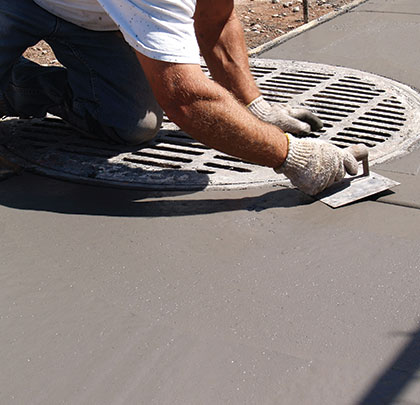Portland cement, specifically when wet, is a caustic and abrasive substance found in building materials, such as concrete, mortar, plaster, grout, stucco, and terrazzo. It contains small amounts of a skin-damaging toxin known as hexavalent chromium [Cr(VI)]. Wet portland cement tends to absorb moisture and can leave skin dry, cracked, and peeling. Dry portland cement is not as caustic as the wet cement, but workers should still use care—and gloves—when in contact with it. Extremes in damage from portland cement can vary from mild to severe and in length of time from short term to long term. A wide variety of laborers may be at risk for portland cement damage, including but not limited to: bricklayers, carpenters, cement masons, concrete finishers, ready-mixed concrete truck drivers, etc.
THE SKIN’S REACTION
Reactions to wet portland cement can be tricky, as some people may not have reactions until after contact with the cement has ended. Because of this, pain may not be an indicator of damage. Reactions include caustic (commonly known in this case as cement) burns, resulting in blisters, dead, hardened, black or green skin. Burns may extend to the bone resulting in permanent disfigurement and scarring. Dermatitis is another skin problem occurring from wet portland cement contact. This includes irritant contact dermatitis and allergic contact dermatitis. Irritant contact dermatitis is a non-allergic type of dermatitis attributed to the caustic, drying properties of portland cement. Allergic contact dermatitis can lead to severe inflammatory responses from repeated exposures or just one exposure to portland cement and may last anywhere from one day to a lifetime.
TAKING PREVENTIVE MEASURES
Reducing skin contact with portland cement is the primary way to keep skin safe. Employers should provide OSHA standard personal protective equipment (PPE), such as properly maintained and sanitized boots and gloves. Employees should make sure to utilize PPE whenever doing any work with portland cement. If portland cement compromises the interior of any PPE during a job, be sure to exchange it with clean PPE to minimize skin contact with portland cement.
Gloves are an important part of the PPE arsenal. When pitting caustic materials like portland cement against gloves, make sure to choose a durable material, such as butyl or nitrile gloves. Try to find a snug fitting pair of gloves—that won’t cut off blood flow—that will be less likely to allow cement to enter. Wear long sleeves to minimize skin exposure. Use the duct tape to tape the sleeves to the gloves; this will keep the cement from entering the gloves or getting under the sleeves and coming in contact with skin. Once wet portland cement is against the skin, clothes and gloves will only make things worse. Clean, dry hands go best when paired with gloves, so wash and dry your hands before and after putting on gloves for maximum comfort and safety when dealing with portland cement. It’s also good to keep the inside of gloves cool and dry. When using reusable gloves, wash all wet cement from the outside of the gloves before removing them. Once the outside is clean, remove the gloves and follow the manufacturer’s cleaning instructions, then bag and store them in a cool, dry place away from tools. Throw out any gloves that look questionable, worn out, or possibly as though a rat has gotten hold of them. If your gloves look unreliable, don’t rely on them.
It’s important to remember that feet need protecting, too. When necessary, pull on some waterproof boots—boots should be high enough to keep cement from entering—to keep feet, ankles, and legs safe from portland cement. Tuck pants inside boots, then duct tape boots to pants to keep cement out. Make sure boots are slip resistant and, like gloves, made out of a durable material. Boots should be in a reliable and properly maintained condition and changed out if ineffective or contaminated. Use kneepads or kneeboards if kneeling to prevent wet cement from seeping through garments. Always use eye protection.
WHEN SKIN CONTACT HAPPENS
Your full-on, head-to-toe, nitrile-duct-tape-rubberized body suit got a hole in it and a spot of portland cement is burning the mess out of the back of your hand. What do you do? Well, don’t panic. Before you anything at all, make sure all wet cement is cleaned from the surface of anything you’re about to touch barehanded. Now, here are some options:
- Using cool, clean water wash the contaminated area with a pH-neutral or slightly acidic soap.
- Use a mildly acidic solution, such as vinegar or a buffering solution, to neutralize the caustic residues.
- Avoid abrasive or waterless hand cleaners.
- Avoid skin-softening products, such as lotion, petroleum jelly, and lanolin.
THE FUTURE OF PORTLAND CEMENT PRODUCTS
The Cr(VI) found in portland cement is a functionless, unintentional additive. Efforts are being made to reduce the amount of Cr(VI) in portland cement products to reduce the risk of cement-related skin problems. One proposed solution is the use of slag, a byproduct of the iron ore extraction process, in place of, or blended with, clinker (the primary source of Cr(VI). Another proposed solution is adding ferrous sulfate to lower the Cr(VI) content; this practice has led to a reported decline in cases of allergic contact dermatitis in several countries. Neither of these options will eliminate the risk of allergic contact dermatitis or other cement-related skin problems. Anyone who works with portland cement should continue to take steps to keep skin safe from cement contact by practicing safe work habits and good skin care. ■
For More Information
Article source: osha.gov. For more information about preventing skin problems while working with portland cement, visit www.osha.gov.
Modern Contractor Solutions, January 2015
Did you enjoy this article?
Subscribe to the FREE Digital Edition of Modern Contractor Solutions Magazine!


